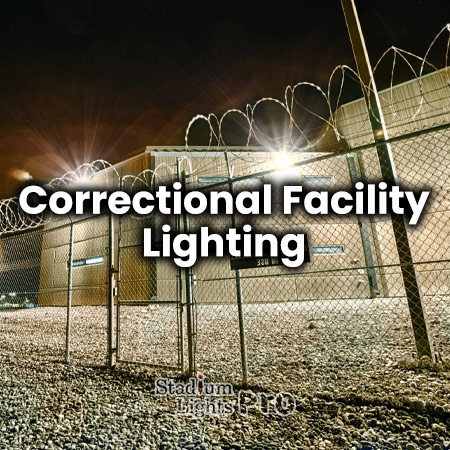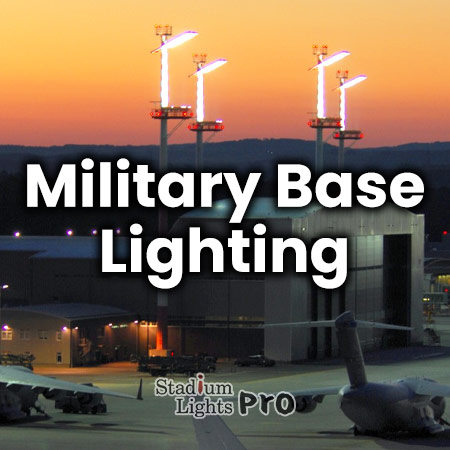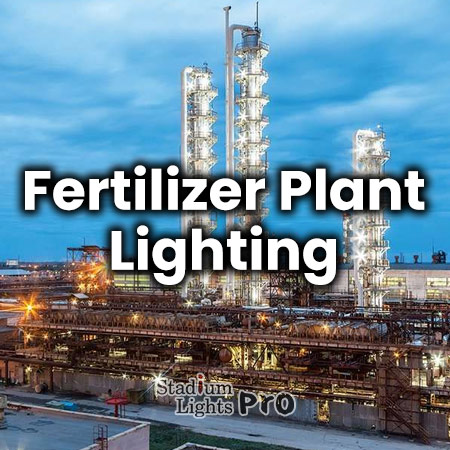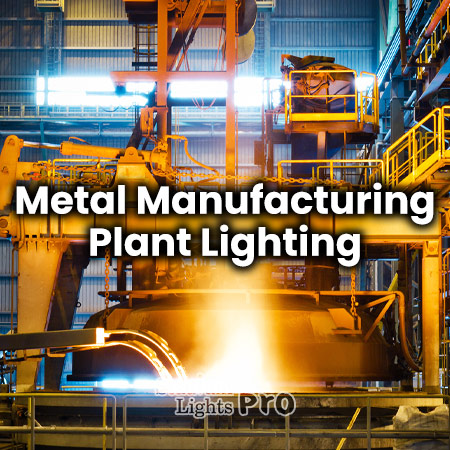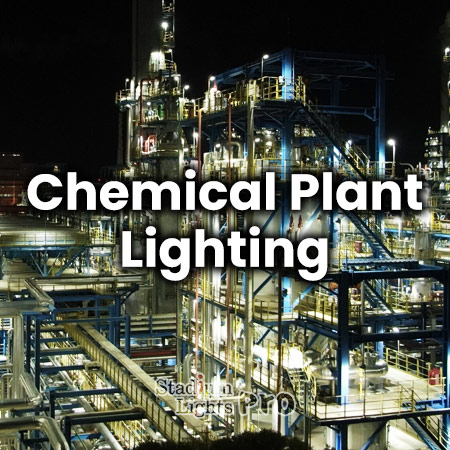Correctional facilities and prisons demand top-tier lighting solutions that are not only efficient but also capable of withstanding challenging environments. LED correctional facility lighting has emerged as the leading choice for these facilities, offering a range of advantages over traditional lighting methods.
Types of lights used in correctional facilities
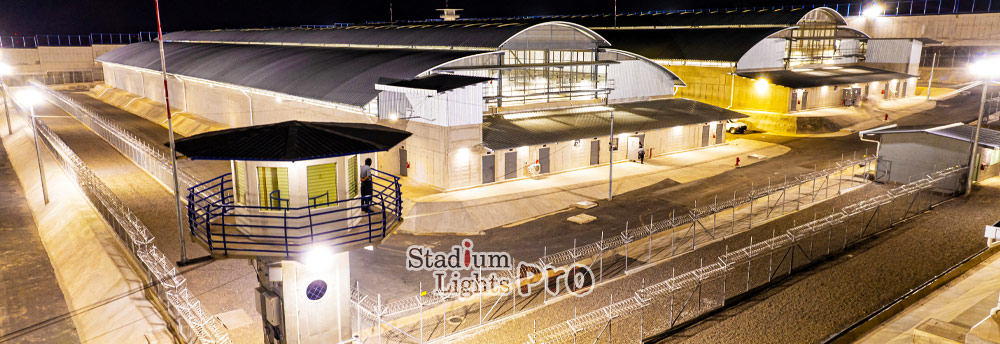
Vandal-resistant lights
Vandal-resistant lights are specifically engineered to endure deliberate acts of vandalism or tampering. These fixtures are designed with robust materials and construction techniques to minimize damage when subjected to physical abuse.
Vandal-resistant LED fixtures often feature components like polycarbonate lenses and durable housings made from heavy-gauge metals. Polycarbonate lenses are exceptionally tough and resistant to impacts, while the metal housing provides additional protection against attempts to break or damage the fixture.
These lights are commonly used in public areas or facilities where there is a risk of vandalism. Examples include transportation hubs, outdoor public spaces, and certain sections within correctional facilities where inmates may attempt to damage lighting fixtures.
Vandal-resistant lights not only enhance the lifespan of lighting fixtures but also help maintain adequate illumination in areas where security is essential. By deterring vandalism, they contribute to overall safety and reduce maintenance costs.
The differences between vandal-resistant and vandal-proof lighting
Vandal-resistant and vandal-proof lights are both designed to withstand intentional damage or tampering, particularly in public spaces or areas where there’s a risk of vandalism. However, there is a subtle difference between the two terms, mainly related to their degree of protection.
| Vandal-resistant lighting | Vandal-proof lighting | |
| Design intent | Vandal-resistant lights are designed to deter or delay acts of vandalism without being completely impervious to damage. They are built to withstand moderate physical abuse but may still be damaged if subjected to severe force. | Vandal-proof lights, on the other hand, are designed to be nearly impervious to vandalism. They are engineered to withstand extreme levels of abuse and tampering, making them highly resistant to damage. |
| Materials | These fixtures are typically constructed using durable materials like polycarbonate or tempered glass for lenses and tough, heavy-gauge metal for the housing. These materials can resist impacts and attempts to break the fixture. | Vandal-proof fixtures are constructed with heavy-duty materials, such as reinforced steel, cast aluminum, or even specialized polycarbonate blends that can resist impacts, attempts to break the lens, or tampering with internal components. |
| Applications | Vandal-resistant lights are commonly used in public areas, parking lots, transportation hubs, and other spaces where the risk of vandalism is present but not extreme. | Vandal-proof lights are typically used in high-risk environments where the risk of vandalism is substantial, such as correctional facilities, psychiatric institutions, or high-crime urban areas. They are also employed in places where public safety and security are paramount. |
| Cost | They are generally more affordable than fully vandal-proof fixtures because they do not need to be as robust. | Vandal-proof fixtures are more expensive than vandal-resistant ones due to their heightened level of durability and security features. |
Explosion-proof lights
Explosion-proof lighting fixtures are a critical safety measure in areas where flammable or combustible materials are present. These fixtures are designed to prevent sparks, arcs, or overheating that could ignite hazardous substances in the environment.
Explosion-proof lights are constructed to contain any potential explosions within the fixture, preventing flames or sparks from escaping. They are typically sealed with heavy-duty gaskets and have reinforced enclosures to withstand pressure from an explosion.
In correctional facilities, explosion-proof lights may be used in areas where flammable gases or chemicals are stored or used, such as certain industrial sections or hazardous material storage areas.
By ensuring that no sparks or heat escapes from the fixture, explosion-proof lights reduce the risk of fires and explosions in potentially dangerous environments.
Waterproof lights
Waterproof LED lights are designed to function reliably in areas exposed to moisture, water, or high humidity levels. These fixtures are sealed and protected against water intrusion, preventing electrical damage and maintaining consistent performance.
Waterproof lights typically feature tight seals around electrical components and connectors, preventing water from entering and causing shorts or corrosion. They are also made from materials that are corrosion-resistant.
Correctional facilities may have areas with high humidity levels, such as showers, outdoor walkways, or underground passages, where waterproof lighting is essential to prevent electrical hazards and ensure longevity.
Waterproof lights help prevent electrical accidents, maintain illumination in wet environments, and reduce the need for frequent maintenance due to water-related damage.
Security lights
Security lights play a vital role in correctional facilities by improving visibility and enhancing surveillance capabilities. Motion-activated LED lights are particularly effective in these environments.
Motion-activated security lights are equipped with sensors that detect movement. When motion is detected, the lights automatically turn on, illuminating the area and potentially deterring unauthorized access or intruders.
These lights can be strategically placed in key locations within the facility, such as perimeter fences, entry points, or critical security checkpoints.
Security lights enhance the security posture of correctional facilities by providing better visibility during nighttime hours and alerting security personnel to potential threats or unauthorized activity.
What are the correctional facility lighting standards?
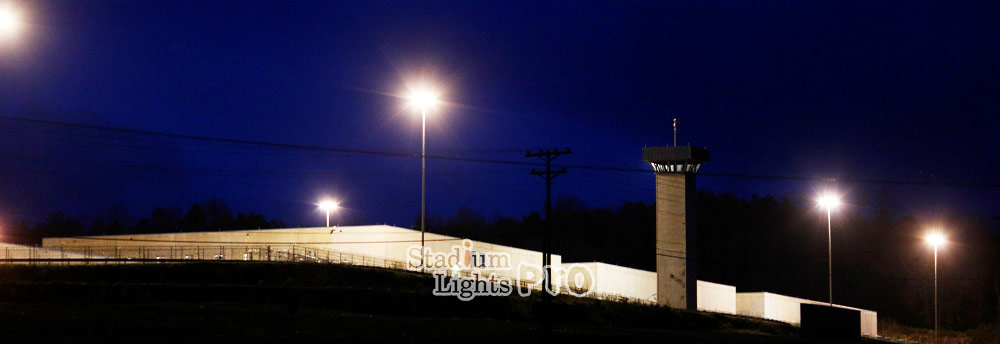
Lighting requirements and standards for correctional facilities are crucial to ensure the safety and security of both inmates and staff, while also maintaining adequate illumination levels for various areas within the facility. These standards are typically established by organizations such as the American Correctional Association (ACA) and the National Institute of Corrections (NIC).
Minimum illuminance levels (Lux)
Cell blocks (20 to 30 lux)
Individual cells typically require a minimum illuminance of 20 to 30 lux. This level of lighting provides enough visibility for inmates to perform basic tasks like reading and personal hygiene without excessive glare.
Common areas (50 to 100 lux)
Corridors, dayrooms, and recreational areas within correctional facilities typically require higher illuminance levels ranging from 50 to 100 lux. This increased brightness ensures better visibility and safety in areas where inmates and staff congregate.
Security and control areas (100 to 300 lux)
Areas like control rooms, surveillance areas, and security checkpoints often necessitate higher levels of illumination, ranging from 100 to 300 lux. These heightened lighting levels are crucial for maintaining vigilance and ensuring accurate monitoring.
Uniformity of illumination
Uniform illumination is a critical aspect of lighting design in correctional facilities, and its importance cannot be overstated. It refers to the consistent distribution of light across an area, ensuring that there are no significant variations in brightness or dark spots.
Minimizing shadows
Enhanced visibility
Uniform lighting minimizes the presence of shadows, which can obscure objects or individuals in an area. In correctional facilities, the ability to see clearly and without obstructions is vital for both safety and security. It allows security personnel to monitor inmate activities effectively and respond to incidents promptly.
Safety
Shadows can create hazards by concealing obstacles or hazards on the floor. Inmate safety and staff safety are top priorities, and uniform illumination helps reduce the risk of accidents or injuries due to obscured hazards.
Consistent visibility
Surveillance
Correctional facilities rely heavily on surveillance cameras to monitor inmate behavior and maintain security. Uniform illumination ensures that surveillance cameras capture clear and well-lit images, even in low-light conditions. This contributes to the effectiveness of security systems and helps deter unauthorized activities.
Identification
In a correctional setting, it’s crucial to accurately identify individuals and objects. Uniform lighting provides consistent lighting conditions for identification processes, which can be essential for tasks such as visitor identification or contraband detection.
Preventing unauthorized activities
Dark spots and concealment
Dark areas or spots with uneven lighting can create opportunities for unauthorized activities, such as contraband exchanges or attempts to tamper with fixtures. By maintaining uniform illumination, correctional facilities reduce the chances of these areas being exploited.
Disrupting unauthorized activities
In areas with uniform lighting, any unauthorized or suspicious activity is more likely to be noticed promptly. This discourages inmates from engaging in prohibited actions, knowing that they are less likely to go unnoticed.
To achieve uniform illumination in correctional facilities, several lighting design strategies may be employed.
Proper fixture placement
Careful placement of lighting fixtures ensures that light is evenly distributed throughout a space. This may involve using a combination of overhead fixtures, wall-mounted fixtures, and task lighting as needed.
Luminance levels
Lighting design should consider the appropriate luminance levels for different areas within the facility. Adequate brightness in common areas and corridors is essential, while individual cells may require lower but still uniform illumination.
Regular maintenance
Maintaining fixtures and replacing bulbs promptly when they begin to degrade is essential for preserving uniform illumination over time.
Color rendering
Accurate color rendering is an essential consideration in correctional facilities for various critical reasons. In this environment, lighting serves more than just the basic function of visibility; it plays a pivotal role in security, safety, and effective operations.
One of the primary reasons why accurate color rendering is crucial is the detection of contraband. Correctional facilities must be able to identify prohibited items effectively, such as weapons, drugs, or smuggled objects. High-quality LED lighting fixtures with good color rendering properties ensure that security personnel can accurately discern the colors of objects, aiding in the detection and confiscation of contraband. The ability to identify these items promptly helps maintain a safe and controlled environment within the facility.
Moreover, accurate color rendering is vital for distinguishing between objects in surveillance footage. Many correctional facilities rely on extensive video monitoring to monitor inmate behavior and maintain security. When the lighting accurately represents colors, security cameras can provide clearer and more detailed images. This is particularly vital when reviewing video footage for incidents, investigations, or identifying specific individuals. Inaccurate color representation could lead to misinterpretations or missed details in critical surveillance footage.
Besides, assessing the condition of inmates is another area where accurate color rendering is crucial. It allows medical personnel and staff to observe and evaluate physical symptoms or injuries more accurately. This can be vital for identifying health issues, injuries resulting from altercations, or signs of distress, ensuring that inmates receive appropriate medical care and attention promptly.
Flicker-free lighting
Comfort and well-being of inmates
Flickering lights can cause discomfort and visual discomfort for inmates. This discomfort can lead to headaches, eyestrain, and increased stress, which can potentially exacerbate tensions within the facility. In a correctional environment, maintaining a calm and controlled atmosphere is essential to prevent conflicts and maintain order. Flicker-free lighting helps create a more comfortable living environment for inmates, contributing to their well-being.
Reduction of health and psychological impact
Prolonged exposure to flickering lights can have negative psychological and physiological effects on individuals. Inmates in correctional facilities are already subject to a challenging and potentially stressful environment. Flicker-free lighting helps mitigate additional stressors and contributes to a more humane and rehabilitative atmosphere.
Enhanced security and surveillance
Surveillance is a critical aspect of correctional facility operations, and security cameras play a central role in monitoring inmate behavior. Flickering lights can interfere with the performance of security cameras, causing disruptions in video footage. This can hinder surveillance efforts and compromise the ability to monitor and respond to incidents effectively.
Accurate identification and assessment
Clear and uninterrupted lighting is crucial for the accurate identification of individuals and objects within the facility. Flickering lights can create shadows and distortions that make it challenging to identify individuals or assess their activities accurately. Inaccurate identification can lead to misunderstandings and security breaches.
Mitigation of disturbances
Flickering lights can be a source of disturbance within the facility. Inmates may react negatively to flickering lights, leading to disturbances, conflicts, or disruptions in daily routines. Maintaining stable and flicker-free lighting helps reduce such disturbances, contributing to overall security and order.
Prevention of contraband or unauthorized activities
In some cases, flickering lights may be exploited by inmates to conceal unauthorized activities or tampering with fixtures. Stable lighting conditions reduce opportunities for exploiting lighting-related vulnerabilities for illicit purposes.
Compliance with safety and health standards
Flicker-free lighting aligns with safety and health standards for correctional facilities. Facilities must meet established standards to ensure the well-being and safety of inmates and staff.
Anti-ligature design
The incorporation of anti-ligature design features in lighting fixtures within correctional facilities, particularly in areas with at-risk populations, is a critical safety measure aimed at preventing self-harm or suicide attempts by inmates.
Prevention of self-harm
In correctional facilities, there are individuals who may be vulnerable and at risk of self-harm or suicide. Ligature points, which are locations where an inmate could attach a cord or fabric to create a makeshift noose, pose a significant risk. Lighting fixtures are one of the potential ligature points within a cell or common area.
Components of anti-ligature design
Elimination of exposed cords
Anti-ligature lighting fixtures are designed to eliminate any exposed cords or cables that could be used for self-harm. This is achieved by concealing wiring within the fixture or housing, making it inaccessible to inmates.
Smooth and rounded edges
Anti-ligature fixtures are constructed with smooth, rounded edges to prevent individuals from using sharp edges to injure themselves. These fixtures are engineered to minimize any potential points where a ligature could be attached.
Break-resistant components
Components within the lighting fixture are designed to be break-resistant. This means that even if an inmate attempts to damage or tamper with the fixture, it is less likely to shatter or break into sharp pieces that could be used for self-harm.
Secure mounting
Anti-ligature lighting fixtures are securely mounted to the ceiling or wall to prevent them from being easily dislodged or removed. Special attention is given to the mounting hardware to ensure it cannot be tampered with.
Reducing risks and liability
Implementing anti-ligature lighting fixtures not only safeguards inmates but also reduces the facility’s liability. Correctional facilities have a duty of care toward inmates, and failing to provide adequate safety measures can result in legal and financial consequences.
Promoting inmate welfare
While correctional facilities are primarily focused on security, inmate welfare is also an essential consideration. Creating an environment that minimizes the risk of self-harm or suicide reflects a commitment to humane treatment and rehabilitation.
Compliance with regulations
Many jurisdictions have specific regulations and standards regarding the prevention of suicide and self-harm in correctional facilities. Incorporating anti-ligature design features in lighting fixtures ensures compliance with these regulations, reducing the risk of non-compliance-related penalties or lawsuits.
Comprehensive safety measures
Anti-ligature design features are part of a broader approach to inmate safety within correctional facilities. This approach includes risk assessment, staff training, mental health support, and the implementation of physical safeguards, all working together to minimize risks.
Vandal resistance
The use of vandal-resistant lighting fixtures in common areas of correctional facilities is essential to prevent tampering, damage, and disruption caused by intentional acts of vandalism. These fixtures are purposefully designed to withstand the harsh prison environment and discourage destructive behaviors.
Prevention of vandalism
Correctional facilities, by their nature, can be challenging environments where inmates may attempt acts of vandalism to express frustration or anger. Vandal-resistant lighting fixtures are designed to deter such actions and reduce the risk of damage.
Components of vandal-resistant design
Robust materials
Vandal-resistant fixtures are constructed using durable and resilient materials such as heavy-duty metals, reinforced polymers, or impact-resistant glass. These materials are chosen for their ability to withstand physical abuse and resist damage.
Tamper-resistant fasteners
Specialized fasteners and screws are used in vandal-resistant fixtures to prevent inmates from easily accessing internal components or disassembling the fixtures.
Secure enclosures
Vandal-resistant fixtures often feature secure enclosures that protect sensitive electrical components, preventing them from being tampered with or damaged.
Reinforced housings
The housings of these fixtures are designed to be tough and resistant to physical impact, reducing the likelihood of breakage or deformation.
Shatter-resistant lenses
In areas where potential violence or vandalism is a concern, vandal-resistant lighting fixtures may feature shatter-resistant lenses that can withstand impact without breaking into sharp pieces.
Cost savings
While vandal-resistant fixtures may have a higher initial cost than standard fixtures, they offer long-term cost savings. By reducing the need for frequent replacements and maintenance due to vandalism-related damage, these fixtures contribute to overall cost efficiency.
Enhanced safety and security
Vandal-resistant lighting fixtures play a crucial role in maintaining safety and security within correctional facilities. Adequate lighting is essential for visibility, surveillance, and the prevention of unauthorized activities.
Compliance with regulations
Many jurisdictions have regulations and standards that require correctional facilities to use vandal-resistant fixtures in specific areas to protect both inmates and staff.
Durability and longevity
Vandal-resistant fixtures are built to last, even in aggressive environments. Their durability ensures that they continue to function effectively for an extended period, reducing the need for frequent replacements.
Reducing disruptions
Acts of vandalism can lead to disruptions in facility operations, necessitating repairs and maintenance. Vandal-resistant fixtures minimize these disruptions by discouraging vandalism and resisting damage.
Control systems
Lighting control systems in correctional facilities are a sophisticated and efficient way to manage illumination, providing flexibility and energy savings while addressing specific security needs. These systems offer various benefits that enhance both security and operational efficiency within the facility.
Adaptive lighting for different times of day
Lighting control systems can adjust illumination levels based on the time of day. In common areas, corridors, and recreational spaces, lighting may be set to a higher intensity during the day to promote visibility and deter unauthorized activities. During the night, the system can automatically dim lights in less-used areas to conserve energy while maintaining a level of safety and security.
Customizable lighting profiles
Facilities can create customizable lighting profiles that align with their specific security and operational requirements. For example, lighting in cell blocks may be adjusted to accommodate inmate routines, providing brighter lighting during wake-up and meal times and dimming during rest periods. These profiles can be easily modified as needed.
Energy savings and cost reduction
Lighting control systems contribute to energy savings by optimizing the use of lighting fixtures. Unnecessary lighting can be reduced or turned off in unoccupied areas, leading to lower energy consumption and reduced utility costs. The long-term financial benefits often outweigh the initial investment in such systems.
Enhancing security
Lighting control systems play a critical role in enhancing security within correctional facilities. In areas requiring constant monitoring, such as control rooms and surveillance zones, lighting can be programmed to ensure consistent, high-level illumination. This minimizes blind spots, enhances surveillance camera performance, and allows security personnel to maintain vigilance effectively.
Emergency lighting integration
Many lighting control systems can integrate with emergency lighting systems, ensuring that emergency lighting activates seamlessly during power outages or emergencies. This feature is essential for maintaining security and orderly evacuation procedures.
Remote monitoring and control
Some advanced lighting control systems allow for remote monitoring and control. Facility operators can adjust lighting levels or profiles remotely, responding to security needs in real time. This capability can be invaluable for managing unexpected situations.
Compliance with local building codes
Adhering to local building codes and regulations is a fundamental aspect of lighting design and installation in correctional facilities. Compliance with these codes ensures that the facility operates within legal and safety standards, minimizing potential liability issues and ensuring the well-being of inmates, staff, and visitors.
Legal obligation
Correctional facilities are subject to local, state, and federal laws and regulations that govern their construction, operation, and safety standards. Compliance with these laws is not optional; it is a legal obligation. Failure to adhere to regulations can result in penalties, fines, and legal liabilities for the facility.
Safety of inmates and staff
Building codes and regulations are primarily established to safeguard the safety and well-being of occupants within a facility. Compliance ensures that the correctional facility is designed and constructed with safety as a top priority, reducing the risk of accidents, injuries, or security breaches.
Liability mitigation
By adhering to building codes and safety regulations, correctional facilities mitigate liability risks. If an incident occurs due to non-compliance with these standards, the facility may face legal consequences and financial liabilities. Compliance reduces the likelihood of such incidents and their associated legal and financial repercussions.
Environmental considerations
Some regulations pertain to environmental considerations, including energy efficiency, waste management, and sustainability. Compliance with these regulations not only reduces the facility’s environmental impact but also aligns with broader sustainability goals and may lead to cost savings over time.
Ensuring proper functionality
Compliance with building codes and regulations ensures that the lighting systems are designed and installed to function correctly and reliably. This includes electrical safety measures, proper circuitry, and lighting fixtures that meet safety standards. Proper functionality is essential for maintaining security, surveillance, and operational efficiency within the facility.
Consistency and uniformity
Building codes help ensure consistency and uniformity in lighting design and installation. This consistency is crucial for maintaining a controlled and predictable environment within the facility, reducing the risk of unforeseen issues or inconsistencies that could compromise safety or security.
Inspection and certification
Correctional facilities are subject to inspections and certifications by relevant authorities or agencies. Compliance with building codes and regulations facilitates the inspection process and provides assurance that the facility meets the necessary standards for operation.
Adaptation to evolving standards
Building codes and regulations may evolve over time to incorporate new safety measures, technologies, or environmental considerations. Compliance requires facilities to stay up-to-date with these changes and adapt their lighting systems accordingly, ensuring that safety standards continue to be met.
Advantages of LED prison lights
Energy efficiency is a top priority for correctional facilities, and LED lighting stands out as a popular and effective choice due to its numerous energy-efficient properties.
Low energy consumption
LED lighting is renowned for its exceptional energy efficiency. It consumes significantly less electricity compared to traditional lighting technologies like incandescent or fluorescent lighting. In a correctional facility, where lighting is required 24/7, this lower energy consumption translates into substantial cost savings on electricity bills.
Extended lifespan
LED fixtures have a remarkably long lifespan compared to traditional lighting sources. A typical LED bulb can last anywhere from 80,000 to 120,000 hours or more, which is several times longer than incandescent or fluorescent bulbs. The extended lifespan of LED fixtures reduces the frequency of replacements, resulting in cost savings on both replacement bulbs and labor for maintenance.
Reduced maintenance costs
Because LED fixtures last longer and are highly durable, they require significantly less maintenance. In a correctional facility, where frequent repairs or replacements can disrupt security operations, minimizing maintenance is crucial. LED lighting’s reliability and reduced maintenance needs contribute to a smoother and more cost-effective facility management.
Lower heat emission
Unlike traditional lighting sources that produce a significant amount of heat, LEDs emit very little heat. This property can reduce the strain on the facility’s cooling systems, leading to additional energy and cost savings, especially in warmer climates.
Instant-on and dimming capabilities
LED lights provide instant illumination when turned on, eliminating warm-up time. Furthermore, LED fixtures can be easily integrated with dimming and control systems, allowing facility operators to adjust lighting levels as needed. This flexibility is useful in creating the right atmosphere for different areas within the facility and optimizing energy use.
Sustainability goals
Correctional facilities often have sustainability goals aimed at reducing their environmental impact. LED lighting aligns with these goals due to its energy efficiency and reduced carbon footprint. By using less energy and lasting longer, LED fixtures contribute to a greener and more sustainable facility.
Financial benefits
The initial investment in LED lighting fixtures may be higher than traditional alternatives, but the long-term financial benefits far outweigh this initial cost. The combination of energy savings, reduced maintenance costs, and extended lifespan results in substantial cost savings over the life of the fixtures.
Improved environmental impact
Correctional facilities that prioritize sustainability aim to reduce their environmental footprint. LED lighting helps achieve this goal by consuming less energy, reducing greenhouse gas emissions, and minimizing the disposal of old bulbs and fixtures.
Types of correctional facilities requiring specialized lighting
Prisons
Robust and durable lighting
Prisons are correctional institutions designed for long-term inmate housing. These facilities require robust and durable lighting solutions due to the extended periods of use and the potential for vandalism or tampering by inmates.
Longevity
In prisons, lighting fixtures need to be able to withstand both normal wear and tear and intentional damage. LED lighting is often favored for its durability and long lifespan, which reduces maintenance needs.
Security and surveillance
Adequate lighting is crucial in prison common areas, cell blocks, and corridors to enhance security and surveillance. It ensures that security personnel can easily monitor inmate activity, detect potential incidents, and maintain a safe environment.
Cell lighting
Individual cells typically have lower lighting levels to provide inmates with adequate but not excessive illumination for tasks like reading or personal hygiene. Vandal-resistant fixtures may be used to prevent tampering.
Detention centers
Secure lighting
Detention centers and holding cells are designed for temporary confinement, often housing individuals awaiting trial or processing. These facilities demand secure lighting that is both robust and tamper-resistant.
Anti-ligature design
Lighting fixtures in detention centers should be designed with anti-ligature features to prevent inmates from using them for self-harm. This includes eliminating exposed cords, sharp edges, and easy-to-break components.
Emergency lighting
Detention centers must also have reliable emergency lighting systems to ensure continued visibility during power outages or emergencies.
High-traffic areas
Lighting in processing areas and waiting rooms should be bright and uniform to facilitate safe movement and security checks.
Courthouses
Well-lit transportation areas
Courthouses often include areas where inmates are transported to and from court appearances. These spaces need well-lit security measures to ensure the safety of all individuals involved.
Visibility and surveillance
Adequate lighting enhances visibility, allowing security personnel to monitor the movements of inmates, law enforcement officers, and the public. This visibility is essential for ensuring the security and smooth operation of court proceedings.
Security checkpoints
Courthouses often have security checkpoints where individuals and belongings are screened. Effective lighting is necessary in these areas to facilitate the screening process and maintain security.
Concealed threat detection
Lighting in courthouses may also include advanced features such as concealed threat detection, which uses specific wavelengths of light to reveal hidden objects or substances.
Correctional facility lighting cost considerations
The cost of purchasing and installing LED correctional facility lighting can vary depending on several factors, including the facility’s size, type of lights required, and any additional features such as motion sensors or dimming capabilities. On average, you can expect to invest in a range of $50 to $200 per fixture. Installation costs will depend on labor rates in your region.
Facility size
The size of the correctional facility plays a significant role in determining the overall cost of LED lighting. Larger facilities will require more fixtures to adequately illuminate various areas, from cell blocks to common spaces and outdoor perimeters.
A larger facility may also have a more extensive electrical infrastructure, potentially impacting installation costs.
Type of lights required
The type of LED lights needed can vary based on the specific requirements of different areas within the facility. Vandal-resistant, explosion-proof, waterproof, and security lighting fixtures may all have different price points.
Some areas may require specialized lighting features, such as anti-ligature fixtures in detention centers. These specialized fixtures can be more expensive than standard options.
Additional features
Correctional facilities often incorporate additional features into their lighting systems to enhance security and efficiency. These features can include motion sensors, dimming capabilities, and remote monitoring.
The inclusion of such features can increase the cost per fixture, but they can also result in long-term cost savings through energy efficiency and reduced maintenance needs.
Fixture quality
The quality and durability of the fixtures also impact cost. High-quality, vandal-resistant, or explosion-proof fixtures made by reputable manufacturers may have a higher initial cost but can provide longer lifespans and reduced maintenance expenses over time.
Installation costs of prison lights
Installation costs for LED correctional facility lighting can vary widely based on several factors.
Labor rates
Labor rates in your region will significantly influence installation costs. Higher labor costs can increase the overall project expense.
Wiring and Infrastructure
The condition and complexity of the existing electrical infrastructure can affect installation costs. Updating or modifying the electrical system to accommodate LED lighting may incur additional expenses.
Location challenges
The layout and accessibility of the facility can impact installation difficulty and costs. For instance, installing outdoor security lighting may require specialized equipment or additional labor.
Maintenance and operating costs
While not part of the initial purchase and installation costs, it’s essential to consider ongoing maintenance and operating costs. LED lighting is known for its energy efficiency, which can result in long-term savings on electricity bills. What is more, the durability of LED fixtures reduces the need for frequent replacements and maintenance, further contributing to cost savings over time.
Conclusion
LED correctional facility lighting represents a significant advancement in correctional facility design, offering enhanced durability, security, and energy efficiency. By carefully selecting the right fixtures, adhering to lux level guidelines, and factoring in special considerations, correctional facilities can provide a safer and more efficient environment for both inmates and staff while also reducing long-term operational costs.
Feel free to reach out to us for a complimentary consultation on correctional facility lighting and prison lighting design. Our team of experts is here to assist you in creating an efficient and secure lighting solution tailored to your specific needs.

